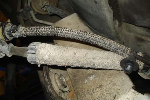pknopick
Member
- Joined
- October 22, 2006
- Messages
- 31
- Reaction score
- 0
- City, State
- Stone Mountain, Georgia
- Year, Model & Trim Level
- 92 XL
While I was changing my oil today, I checked my brake fluid. I inspected the color and noticed that it was as dark (and almost as thick) as oil coming out of my engine... I'm no expert but I'm guessing that the color is from years of corrision and rust. I took the top off a spray bottle and removed 85% of all the fluid out of the reservior and replaced it with fresh DOT3. Does the coloration indicate a future problem? And how would I correct it if it is a problem?

 NEVER EVER DRAIN the master cylinder... doing so will most definitely trap air inside which will be a huge PITA to get out resulting a a spongy brake pedal.
NEVER EVER DRAIN the master cylinder... doing so will most definitely trap air inside which will be a huge PITA to get out resulting a a spongy brake pedal. 








